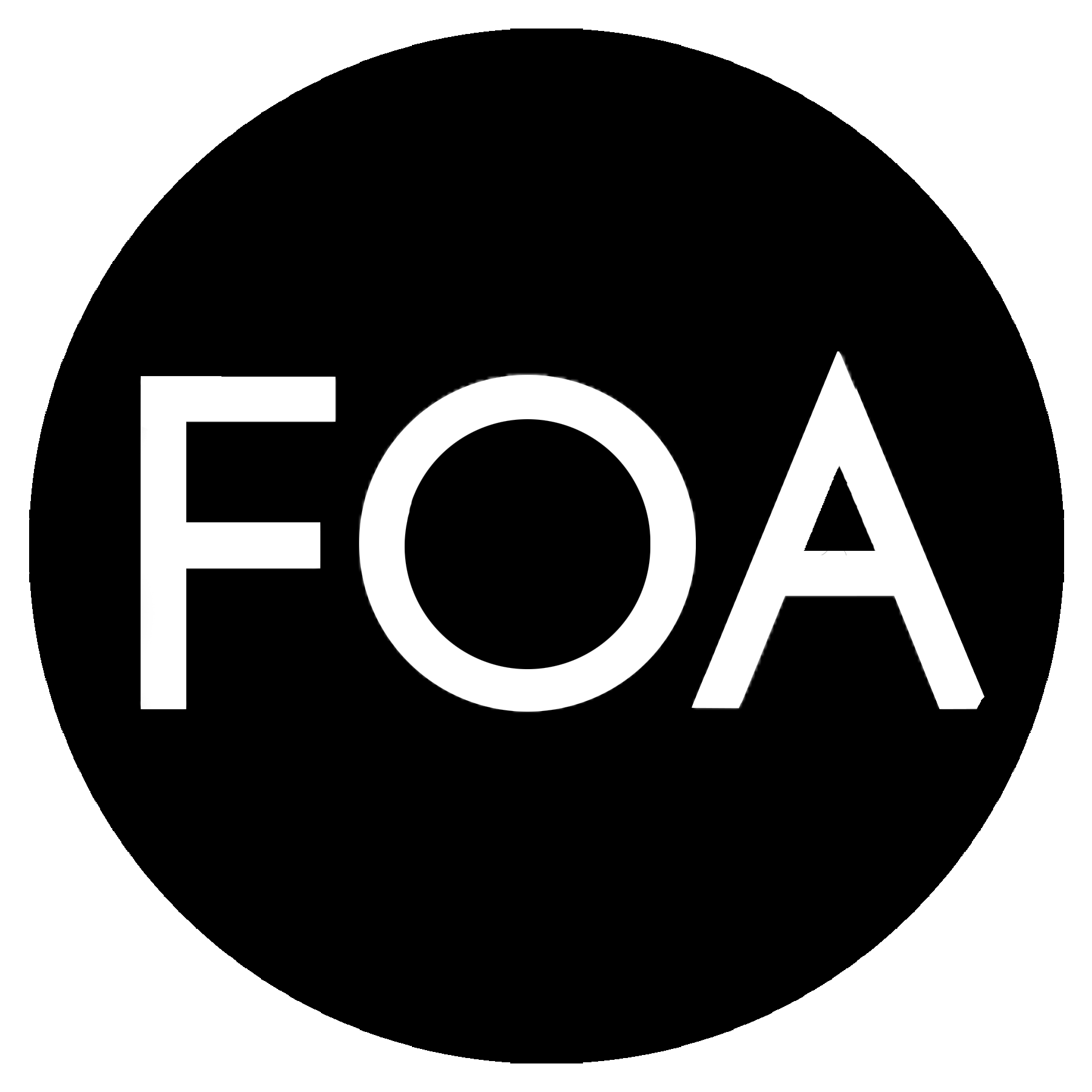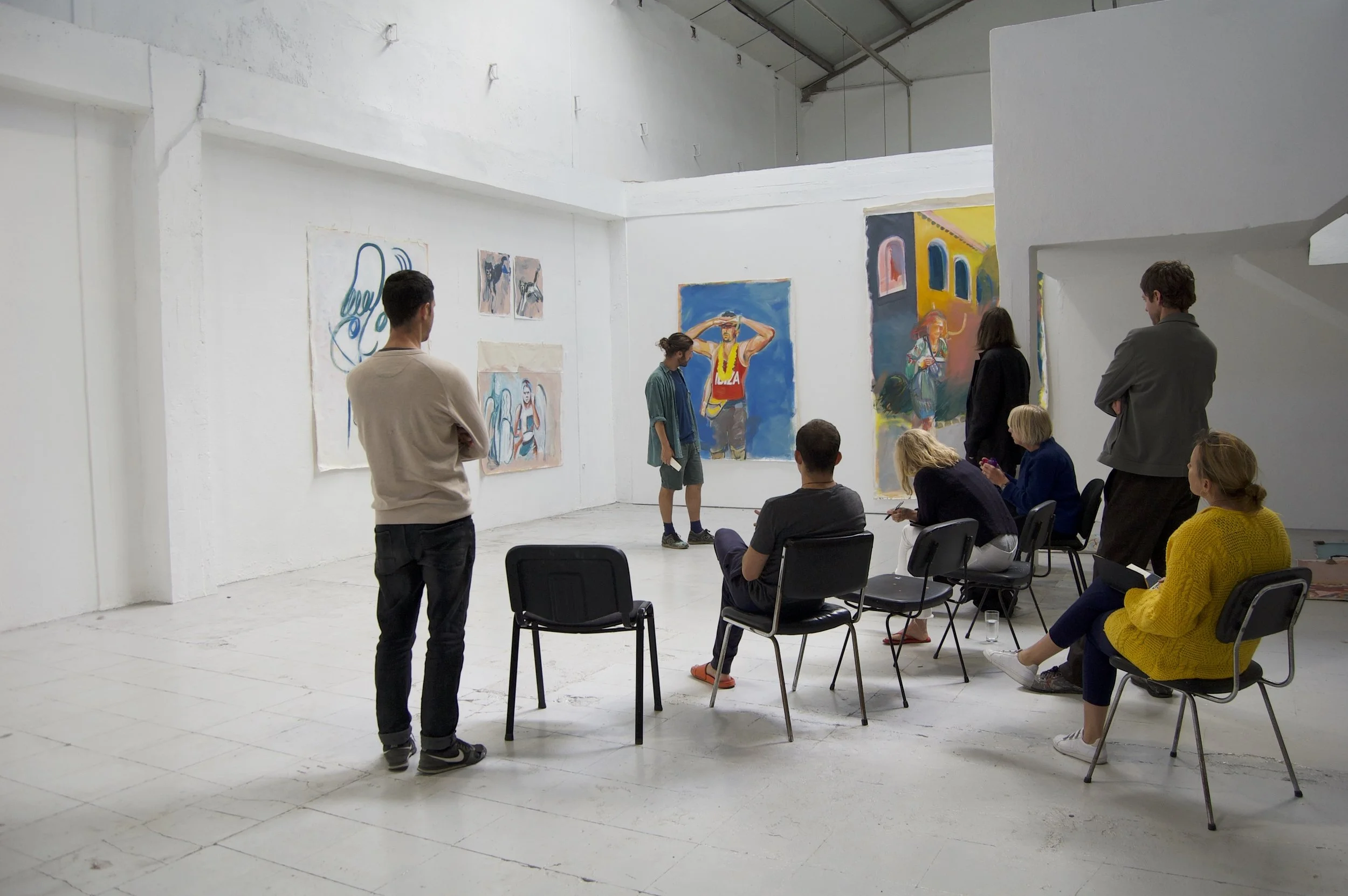Interview with PADA Studios + Residency
Critique at PADA in Lisbon, Portugal
Based in Lisbon, Portugal, PADA is an artist's and a curator's dream come true. From inside a reclaimed industrial park dating back to 1885, PADA promotes interaction between national and international artists, the local community and surrounding region through their residency, studio & gallery programs.
In this interview, Ty Bishop and Justin Archer of FOA speak with Tim Ralston and Diana Cerezino who founded PADA in 2018.
Ty: Can you share a little about your backgrounds and how you both got started in the arts?
Tim: I grew up in London and after a degree in fine art worked in galleries and institutions and then moved on to working in artists ateliers. About 5 years ago I went freelance so that I could be a bit more flexible around creating projects of my own. Before moving to Lisbon I was director of an arts festival in South London and also ran a project space called Recreational Grounds.
Diana: I grew up in Lisbon and moved to London 13 years ago to go to art school. Having graduated I stayed and continued my practice alongside working in a variety of galleries and projects in London.
We met 3 years ago when Tim had an exhibition at a gallery I was working at.
Ty: Where did the idea of PADA come from?
Diana: We both had ambitions to start a project like this before we met. It was an idea that we both had in common. So when we started visiting family in Portugal we really enjoyed exploring abandoned buildings of the old industrial areas around Lisbon. Old factories are everywhere and we loved imagining the projects we could create in them.
Tim: It began as a dream, a way to start a new life in Lisbon, but when we found our current location we quickly realised it was possible to make it happen. We sketched out a very rough plan at that stage but talked to lots of people and took a lot of advice. From that point, we decided to commit to the idea and invested everything in the project, PADA grew very quickly and we have worked solidly to turn the idea into a reality.
Justin: What you are doing for artists is really incredible, what led you to take your collective experience and use it to serve emerging artists?
Tim Ralston and Diana Cerezino
Diana: As artists our experience of living and working in London showed us that it is so difficult to make the work you want to. Unless you are lucky, ideas don’t get realised through a lack of time, finances or space.
Tim: Our professional experience in London had shown us all sides of the art world and we were definitely drawn to the artist led end of the spectrum. Working for the big galleries with huge budgets taught us a lot but the excitement, passion and initiative that happens within the artist led culture even despite the constant lack of funds is where we are both drawn. We both really enjoy the process of turning ideas into artwork and the journey that happens along the way. We want to make PADA a place that can help this happen, to create opportunities for artists.
Justin: Can you share a little bit about the residency? What does the day to day look like for everyone involved?
Diana: The resident's accommodation is a short walk away from the studios across the industrial park in the old workers quarter. Everybody is generally in the studio by 10, and the day starts over a coffee with discussions ranging from the night before to plans for the day ahead but quickly comes round to events in the studios. As the accommodation is so close, artists spend a lot of time at work and there is a definite focus and energy, with productivity always high. At the beginning of each month we run tours of the industrial park and host events and talks, the following weeks, we like to let the residents structure their time. This way individuals can create routines to suit their practice. We are always around to help but don’t want to force too much supplementary events on top of studio time.
Things begin to wind up in the studios around 7 and we gather for a drink and often eat as a big group in the kitchen at the studios or at one of the local restaurants. Once or twice a week we will organise a talk or presentations as a way to encourage discussion within the group.
Ty: What drew you to start PADA in Lisbon?
Tim: Lisbon and in particular the south bay, is the ideal place to start a project like this. Aside from the great quality of life, the space is affordable, people are welcoming, and the art scene is exciting to be around.
Diana: It was the right time in both our lives and also a good time to start a project here. We were also lucky to have my family close by who have been tremendous support in beginning this venture.
Ty: PADA is such a unique space in a unique setting. Can you tell us about how you found the space to begin with?
Tim: We were searching around the south bay of Lisbon because of the greater space it offers whilst also being really close to the centre of Lisbon. We had been recommended to check out Barreiro, a once booming industrial town but more recently reverting to the fishing village it had once been. We had no idea what we would find, but were amazed to find vast areas of land and enormous vacant warehouses. We walked into the offices of the management company, Baia do Tejo, off the street and straight into a boardroom and meeting with two of the directors. It isn’t a small company, they manage hundreds of warehouses and factories across the south bay, and we had no idea. It was just the perfect timing and they were open and gave us the opportunity to explain our idea. Our passion came across and they were excited to show us spaces that might work for the project. When we found the warehouse we now have, we knew it was perfect. The light and space was amazing, and the architecture of the space created an inspiring location for the residency.
Diana: As we continued to learn more about the surroundings we realised how much potential the area has, and how unique it is.
Santa Barbara, the old workers quarter, from when the factories were operational had been virtually deserted for some time. Some of the cottages where being used as offices but other than that very few people actually lived there. We took two cottages to provide accommodation for visiting artists and they work brilliantly, immersing artists in life in the industrial park. Also close by we found a great art shop, many local fabricators and craftsmen, good bars and restaurants and local markets.
Justin: How have you seen artists be influenced from and interact with this location?
Diana: Each artist that comes finds a completely unique way to respond to the landscape and history of Companhia Uniao Fabril and Barreiro. Artists take inspiration from the crumbling brutalist architecture or the alien like landscapes of the old chemical processing plants. Some look into the history, the politics of the area and how the industrial revolution shaped Portugal. Other artists are inspired by the contemporary aspects of the area and the art scene.
Tim: The variety in artistic responses has been wonderful, through the lens of a fresh perspective artists have highlighted and explored new areas and unique perspectives. We have seen automated drones chase a warrior across the pyrite fields, seen sunlight manipulated to emphasise the folds of architecture. We have made edible soap and inedible sausages, observed and recorded subtle narratives and fabricated others. Explored archives and history, materials and surfaces. Artists have borrowed objects, discovered relics, built walls and knocked them down. They have intervened in space, altered facades and observed life. Written poems, journals and stories - created form, shape and tone.
Diana: It has been incredible to see how all the artists have interacted with our location, both professionally and personally.
Ty: Lisbon has been talked about being one of the hottest art capitals in the world. How do you feel that artists benefit from spending a residency a stones throw away from the city?
Tim: I think it is really important to relate the residency with the art scene in Lisbon. Outside of the established galleries and museums, there is also a booming artist led scene with projects happening across the city.
PADA Industrial Park in Lisbon, Portugal
Diana: Historically and culturally the city is so rich and can provide energy and inspiration for artists. Practically we try to get over at least once a week as a group to tour openings and galleries but as it is so easy to hop on the ferry artists venture over quite frequently to explore by themselves.
Justin: What has been the most significant moment for you through building this residency?
Tim: I think finding the space… at that point we both knew it would happen.
Diana: After 6 months, we had an exhibition at Auditorio Municipal August Cabrita. We showed work from many of the artists who had stayed with us and had made work at PADA. We had been working so hard up to that point it was great to take a step back and to look at what had been achieved, the show looked amazing and the variety of work by artists from all over the world was more than we could have ever imagined. The reaction from locals was also really encouraging. The exhibition was really busy and the feedback was great.
Ty: What would you say is the ultimate goal of PADA?
Diana: We would like PADA to be known and respected as a destination for artists. A community of artists focused on producing exciting and ambitious artwork.
Tim: In the next few years we want to work on our facilities for fabrication and continue to bring new ways of making to inspire and challenge artists.



